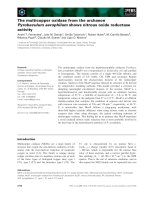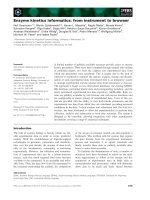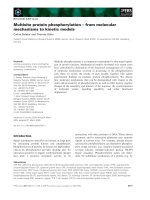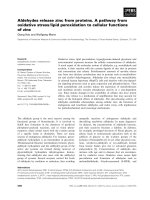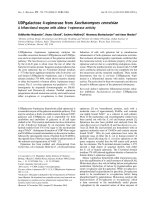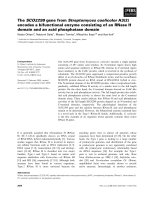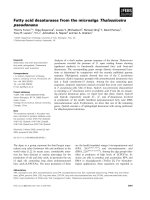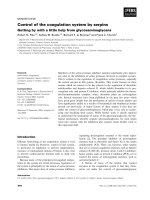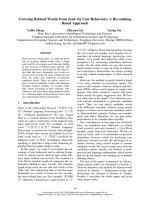Báo cáo khoa học: Weak toxin WTX from Naja kaouthia cobra venom interacts with both nicotinic and muscarinic acetylcholine receptors potx
Bạn đang xem bản rút gọn của tài liệu. Xem và tải ngay bản đầy đủ của tài liệu tại đây (263.26 KB, 11 trang )
Weak toxin WTX from Naja kaouthia cobra venom
interacts with both nicotinic and muscarinic acetylcholine
receptors
Dmitry Yu. Mordvintsev
1
, Yakov L. Polyak
1,
*, Dmitry I. Rodionov
1,
, Jan Jakubik
2
,
Vladimir Dolezal
2
, Evert Karlsson
3
, Victor I. Tsetlin
1
and Yuri N. Utkin
1
1 Shemyakin-Ovchinnikov Institute of Bioorganic Chemistry RAS, Moscow, Russia
2 Institute of Physiology, Prague, Czech Republic
3 Institute of Biochemistry and Organic Chemistry, Uppsala, Sweden
Introduction
Two main classes of acetylcholine (ACh) receptors
(AChRs) are involved in cholinergic transmission. The
nicotinic AChRs (nAChRs) are activated by nicotine
and belong to the ligand-gated ion channel superfam-
ily, whereas muscarinic AChRs (mAChRs) are
activated by muscarine and belong to the family of
Keywords
muscarinic acetylcholine receptor; nicotinic
acetylcholine receptor; snake venom; weak
neurotoxin
Correspondence
Y. N. Utkin, Shemyakin-Ovchinnikov
Institute of Bioorganic Chemistry RAS, ul.
Miklukho-Maklaya 16 ⁄ 10 Moscow, 117997
Russia
Fax: +7 495 335 57 33
Tel: +007 495 336 65 22
Present addresses
*Max-Planck-Institute fur Kohlenforschung,
Mulheim an der Ruhr, Germany
McGill University, Montreal, Canada
(Received 16 December 2008, revised 25
May 2009, accepted 7 July 2009)
doi:10.1111/j.1742-4658.2009.07203.x
Iodinated [
125
I] weak toxin from Naja kaouthia (WTX) cobra venom was
injected into mice, and organ-specific binding was monitored. Relatively
high levels of [
125
I]WTX were detected in the adrenal glands. Rat adrenal
membranes were therefore used for analysis of [
125
I]WTX-binding sites.
Specific [
125
I]WTX binding was partially inhibited by both a-cobratoxin,
a blocker of the a7 and muscle-type nicotinic acetylcholine receptors
(nAChRs), and by atropine, an antagonist of the muscarinic acetylcholine
receptor (mAChR). Binding to rat adrenal nAChR had a K
d
of 2.0 ± 0.8 lm
and was inhibited by a-cobratoxin but not by a short-chain a-neurotoxin
antagonist of the muscle-type nAChR, suggesting a specific interaction with
the a7-type nAChR. WTX binding was reduced not only by atropine but
also by other muscarinic agents (oxotremorine and muscarinic toxins
from Dendroaspis angusticeps), indicating an interaction with mAChR. This
interaction was further characterized using individual subtypes of human
mAChRs expressed in Chinese hamster ovary cells. WTX concentrations
up to 30 lm did not inhibit binding of [
3
H]acetylcholine to any subtype of
mAChR by more than 50%. Depending on receptor subtype, WTX either
increased or had no effect on the binding of the muscarinic antagonist
[
3
H]N-methylscopolamine, which binds to the orthosteric site, a finding
indicative of an allosteric interaction. Furthermore, WTX alone activated
G-protein coupling with all mAChR subtypes and reduced the efficacy of
acetylcholine in activating G-proteins with the M
1
,M
4
, and M
5
subtypes.
Our data demonstrate an orthosteric WTX interaction with nAChR and
an allosteric interaction with mAChRs.
Abbreviations
ACh, acetylcholine; AChR, acetylcholine receptor; Bgt, a-bungarotoxin; CHO, Chinese hamster ovary; CTX, a-cobratoxin; mAChR, muscarinic
acetylcholine receptor; MT1, muscarinic toxin 1; MT2, muscarinic toxin 2; MT3, muscarinic toxin 3; MT7, muscarinic toxin 7; nAChR,
nicotinic acetylcholine receptor; NMS, N-methylscopolamine; NTII, neurotoxin II of Naja oxiana; QNB, quinuclidinyl benzilate; SEM, standard
error of the mean; WTX, weak toxin from Naja kaouthia.
FEBS Journal 276 (2009) 5065–5075 ª 2009 The Authors Journal compilation ª 2009 FEBS 5065
G-protein-coupled receptors. Both receptor families
comprise multiple subtypes, and whereas nAChRs pre-
dominantly control fast synaptic neurotransmission,
mAChRs control the slower processes of smooth mus-
cle contraction and secretion.
Both AChR types are activated by ACh, but their
antagonists are generally type-specific. For example,
snake venoms contain toxins of the three-finger toxin
family [1], which specifically block either mAChRs or
nAChRs. So-called muscarinic toxins isolated from
mamba venoms specifically interact with different sub-
types of mAChRs [2], whereas a-neurotoxins present in
Elapidae venoms specifically block muscle-type and a7
nAChRs [3,4]. Elapidae venoms also contain so-called
weak or nonconventional toxins [5]. It was recently
shown [6–10] that these toxins also interact in vitro with
muscle-type and a7 nAChRs, but with lower affinity
than a-neurotoxins. Weak toxins are members of the
three-finger toxin family, which contain a triple-fingered
structural fold stabilized by five disulfide bridges [5].
Weak toxins possess an additional disulfide in loop I
that is also present in the endogenous nAChR modula-
tors lynx1 and SLURPs [11,12].
We previously reported that weak toxin from
Naja kaouthia (WTX) produces hemodynamic and
behavioral effects in rodents that can be explained by
its interaction with mAChR [13,14]. We now report
the in vivo distribution of radiolabeled WTX in mouse
organs and specific binding to rat adrenal membranes.
This interaction was inhibited by both nicotinic and
muscarinic ligands, suggesting that WTX interacts with
both nAChR and mAChR. Experiments using hetero-
logous expression of mAChRs revealed that the mech-
anism of WTX interaction with mAChRs is allosteric.
This is the first report that WTX interacts with both
nAChRs and mAChRs. Furthermore, the binding
mechanisms were found to be different: we report that
WTX binds to the orthosteric site (the site where the
endogenous ligand ACh binds) of nAChR, whereas its
interaction with mAChR is allosteric.
Results
Distribution of WTX binding in mouse organs
Mice were injected intraperitoneally with radiolabeled
WTX, and organ-specific radioactivity was monitored
5–30 min postinjection. Relatively high levels of radio-
activity were detected in adrenal gland, muscle, dia-
phragm, and spleen, whereas only low levels were
detected in heart, lung, brain, and spinal cord. The
accumulation of radioactive WTX in muscles and dia-
phragm is consistent with WTX binding to resident
muscle-type nAChRs. On the other hand, retention in
spleen, which does not contain nAChRs, indicates that
WTX can bind to other target sites. Notably, high lev-
els of WTX were retained in the adrenal gland.
Although a-bungarotoxin (Bgt)-binding sites in
adrenomedullary chromaffin cells were previously dem-
onstrated by autoradiography [15], nAChR density in
the adrenal gland was not investigated.
WTX binding to rat adrenal membranes
To identify WTX-binding sites in the adrenal gland,
we studied the interaction with rat adrenal membranes.
[
125
I]WTX bound specifically to these membranes
(Fig. 1) with relatively low affinity (K
d
of 0.3–0.6 lm,
B
max
of 138 ± 32 pmolÆmg protein
)1
). Binding was
only partially inhibited by a-cobratoxin (CTX), a
selective antagonist of the a7 and muscle nAChRs,
and residual binding had a K
d
of 50 ± 20 nm and a
B
max
of 30 ± 8 pmolÆmg protein
)1
[Fig. 1, calculated
from Eqn (1); see Experimental procedures]. On the
basis of these parameters, the affinity of WTX for
the CTX-dependent site was calculated using Eqn (2)
(Experimental procedures), yielding a K
d
of 2.0 ±
0.8 lm. This value is in good agreement with IC
50
values obtained in competition experiments.
To investigate the levels of nonspecific binding of
[
125
I]WTX, we performed competition studies with dif-
ferent concentrations of native WTX. Binding was
almost completely inhibited at high WTX concentra-
tions (Fig. 2). High concentrations of another weak
toxin (weak toxin from the cobra Naja oxiana; Uni-
ProtKB accession number P85520) also completely
Fig. 1. Curve 1 shows binding of [
125
I]WTX to rat adrenal gland
membranes; curve 2 shows binding in the presence of 100 l
M
CTX. Nonspecific binding was determined in the presence of
100 l
M WTX.
Weak toxin binds two acetylcholine receptor types D. Yu. Mordvintsev et al.
5066 FEBS Journal 276 (2009) 5065–5075 ª 2009 The Authors Journal compilation ª 2009 FEBS
inhibited [
125
I]WTX binding to adrenal membranes
(not shown). The binding curve in competition experi-
ments with native WTX was indicative of two types of
[
125
I]WTX-binding site (Fig. 2) with calculated IC
50
values of 92 nm and 26 lm.
Low molecular weight AChR ligands also competed
with [
125
I]WTX for binding to adrenal membranes. The
ganglionic nicotinic blocker hexamethonium inhibited
binding by about 60% at a concentration of 1.5 mm.
The same effect was observed for the nicotinic agonist
choline, and 1 mm carbamoylcholine, a nonselective
agonist of mAChRs and nAChRs, almost completely
inhibited [
125
I]WTX binding. The mAChR-selective
ligands atropine and oxotremorine M inhibited binding
by about 40% at 1 mm (data not shown).
To further characterize [
125
I]WTX binding to adre-
nal membranes, we performed competition experiments
using CTX and the muscle-type nAChR-selective short
neurotoxin II of N. oxiana (NTII). NTII had no effect
on [
125
I]WTX binding, and CTX, even at high concen-
trations ($ 100 lm), inhibited binding only partially
($ 60% of total specific binding). In contrast, WTX
completely inhibited [
125
I]CTX binding to adrenal
membranes, with an IC
50
of about 13 lm (Fig. 3).
It was previously shown that WTX inhibits binding
of [
125
I]Bgt to Torpedo nAChR with an IC
50
of 2.2 lm
[6]. We directly analyzed the binding of [
125
I]WTX to
Torpedo membranes, and found that this was inhibited
by native WTX with an IC
50
of 2.95 lm (data not
shown), in good agreement with the previously
reported IC
50
value.
Taken together, these data show that WTX interacts
with both muscle-type and a7-like nAChRs with
micromolar affinity, in accord with an earlier report by
Utkin et al. [6].
In view of our previous data pointing to mAChR
involvement in the biological effects of WTX in vivo
[13,14], we tested the influence of muscarinic ligands
on [
125
I]WTX binding to adrenal membranes. After
sequential incubation of membranes with CTX, with
high concentrations of atropine, and finally with
[
125
I]WTX, specific binding of [
125
I]WTX was com-
pletely inhibited. The same effect was observed if the
membranes were incubated first with atropine and then
with CTX followed by [
125
I]WTX.
Muscarinic toxin 1 (MT1) and muscarinic toxin 2
(MT2) from Dendroaspis angusticeps competed with
[
125
I]WTX for binding to adrenal membranes, whereas
muscarinic toxin 3 (MT3) did not inhibit WTX bind-
ing at concentrations up to 10 lm. This competition
was characterized by IC
50
values of 31 ± 8 and
52±14nm for MT1 and MT2, respectively (Fig. 4).
Fig. 2. Inhibition of [
125
I]WTX binding to rat adrenal gland mem-
branes by different concentrations of WTX.
Fig. 3. Inhibition of [
125
I]CTX binding to rat adrenal gland mem-
branes by different concentrations of WTX.
Fig. 4. Inhibition of [
125
I]WTX binding to rat adrenal glands mem-
branes by muscarinic toxins MT1 (s) and MT2 (d).
D. Yu. Mordvintsev et al. Weak toxin binds two acetylcholine receptor types
FEBS Journal 276 (2009) 5065–5075 ª 2009 The Authors Journal compilation ª 2009 FEBS 5067
Both toxins almost completely (96%) inhibited
[
3
H]atropine and [
3
H]quinuclidinyl benzilate (QNB)
binding to adrenal membranes. The competition with
atropine had K
i
values of 80 ± 36 nm and
1.4 ± 0.3 lm for MT1 and MT2, respectively (data
not shown). MT3 did not influence atropine binding at
concentrations up to 10 lm. Blockade of WTX binding
to adrenal membranes by muscarinic ligands demon-
strates a specific interaction of WTX with mAChRs.
WTX interaction with heterologously expressed
mAChRs
To characterize the WTX interaction with mAChR in
more detail, we performed competition experiments
using five human mAChR subtypes expressed in
Chinese hamster ovary (CHO) cells. Radiolabeled
competitors were [
3
H]ACh and methyl-[
3
H]-N-methyl-
scopolamine ([
3
H]NMS). Data obtained in equilibrium
binding experiments were fitted to Eqn (2) (Experimen-
tal procedures). The following equilibrium dissociation
constants (K
d
) were measured and used for fitting: for
[
3
H]NMS binding to the M
1
,M
2
,M
3
,M
4
and M
5
receptors, K
d
values were, respectively, 240, 320, 235,
225 and 280 pm; for [
3
H]ACh, the K
d
values were,
respectively, 240, 320, 235, 225 and 280 pm. The calcu-
lated WTX-binding parameters, i.e. equilibrium disso-
ciation constants (K
a
) and factors of cooperativity (a),
are summarized in Table 1.
These experiments demonstrate that WTX binds to
all subtypes of mAChRs with affinities in the sub-
micromolar range (Fig. 5, Table 1), although the toxin
displays a slight preference for the M
2
and M
5
recep-
tors. The cooperativity of binding between WTX and
[
3
H]NMS was either neutral (M
2
,M
4
, and M
5
)or
positive (M
1
and M
3
), and the cooperativity of binding
between WTX and [
3
H]ACh was either neutral (M
3
)or
negative (M
1
,M
2
,M
4
, and M
5
).
To further characterize the influence of WTX on sig-
nal transduction via different mAChR subtypes, we
investigated G-protein activation by ACh in the
absence or presence of saturating concentrations
(1 lm) of WTX, or by WTX itself (Fig. 6). WTX had
no effect on [
35
S]GTP[cS] binding in control experi-
ments using membranes from nontransfected CHO
cells. The results summarized in Table 2 show that
WTX alone significantly stimulated [
35
S]GTP[cS] bind-
ing with submicromolar potency in transfected cells,
although the maximal effect was always less than for
ACh. However, at the M
2
,M
4
and M
5
receptors,
WTX potencies in stimulating [
35
S]GTP[cS] binding
represented 34%, 29% and 43% of the E
max
for ACh.
ACh alone stimulated [
35
S]GTP[cS] binding with
Table 1. Parameters of WTX binding to membranes from CHO
cells expressing mAChRs. The equilibrium dissociation constant
(K
a
) and factor of cooperativity (a) were obtained by fitting the data
to Eqn (3) (see Experimental procedures). K
a
and a are expressed
as negative logarithms of means ± SEMs from four independent
experiments performed in quadruplicate. NE, no effect.
[
3
H]ACh [
3
H]NMS
pK
a
pa pK
a
pa
M
1
5.83 ± 0.17* )0.081 ± 0.057 6.35 ± 0.02 0.59 ± 0.02
M
2
6.80 ± 0.06 )0.25 ± 0.04 7.13 ± 0.25* )0.08 ± 0.04
M
3
NE NE 6.51 ± 0.03 0.42 ± 0.02
M
4
6.67 ± 0.07 )0.18 ± 0.05 NE NE
M
5
6.83 ± 0.05 )0.32 ± 0.03 N0045 NE
*P< 0.05, pK
a
is significantly different from the rest by ANOVA
and Tukey–Kramer post hoc test.
Fig. 5. Effects of WTX on [
3
H]NMS and [
3
H]ACh binding to mem-
branes from CHO cells expressing heterologous mAChR subunits.
Binding of [
3
H]ACh (A) and [
3
H]NMS (B) in the presence of WTX
(concentrations as indicated on the x-axis) was to membranes from
CHO cells expressing M
1
(circles), M
2
(squares), M
3
(diamonds),
M
4
(upwards-pointing triangles) and M
5
(leftwards-pointing trian-
gles) receptors; binding levels are expressed as percentage binding
in the absence of WTX. Data are means ± SEMs of quadruplicate
measurements from three independent experiments.
Weak toxin binds two acetylcholine receptor types D. Yu. Mordvintsev et al.
5068 FEBS Journal 276 (2009) 5065–5075 ª 2009 The Authors Journal compilation ª 2009 FEBS
micromolar potency. WTX at 1 lm did not markedly
change the [
35
S]GTP[cS]-binding potency of ACh, with
the exception of M
5
receptors, where it caused an
approximately three-fold decrease, whereas ACh
potency was reduced by 19%, 58% and 46% at the
M
1
,M
5
and M
4
receptors, respectively.
In these experiments, there were significant differ-
ences in both EC
50
and E
max
values, according to the
individual mAChR subtype expressed. This suggests
that the effects of WTX on GTP binding are due to an
interaction with the mAChRs, and that WTX does not
interact directly with the G-proteins themselves: signifi-
cant differences in [
35
S]GTP[cS] binding according to
receptor subtype are not consistent with a direct effect
of WTX on G-proteins.
Discussion
It was previously reported that WTX injection into
mice and rats produces signs of intoxication consistent
Fig. 6. Stimulation of [
35
S]GTP[cS] binding to membranes from CHO cells expressing heterologous mAChRs. Binding of [
35
S]GTP[cS] to
membranes from CHO cells expressing the indicated mAChR subtype was performed in the presence of WTX (triangles), ACh (circles) or
ACh and 1 l
M WTX (squares) at the concentrations indicated on the x-axis. The extent of stimulation is expressed as fold increase over basal
[
35
S]GTP[cS] binding. Data are means ± SEMs of quadruplicate measurements from three independent experiments.
D. Yu. Mordvintsev et al. Weak toxin binds two acetylcholine receptor types
FEBS Journal 276 (2009) 5065–5075 ª 2009 The Authors Journal compilation ª 2009 FEBS 5069
with WTX interactions with both nAChRs and mAChRs
[13,14]. To determine the organs affected by the toxin
in vivo, we studied the distribution of [
125
I]WTX
following intraperitoneal injection into mice. High lev-
els of WTX accumulated in the adrenal gland, and
this organ was selected for further analysis. Neuronal
nAChRs of various types (including a7), mAChRs,
adrenoreceptors and some neuropeptide receptors are
known to be expressed in the adrenal gland [15–19];
indeed, chromaffin cells are known to be modified
postganglionic neurons. However, although a7-type
receptor gene expression has been reported in this
tissue [17], neither a7 immunoreactivity nor functional
a7 receptors have been described. This may be
explained by mRNA splicing variations [18] or by a7
complex formation with other subunits to generate a
heteromeric a7-like receptor [19].
We then studied [
125
I]WTX binding to membrane
preparation. Binding activity was first tested with
Torpedo membranes containing a muscle-type nAChR.
Competition experiments with native WTX gave an
IC
50
of 2.95 lm, in good agreement with an earlier
value of 2.2 lm obtained from [
125
I]Bgt competition
studies [6]. In further experiments, rat adrenal mem-
brane preparations were used. Saturable specific bind-
ing of [
125
I]WTX (Fig. 1) was almost completely
inhibited by carbachol (not shown), a nonselective ago-
nist of nAChRs and mAChRs. In contrast, binding
was only partially inhibited by atropine (binding
reduced by $ 40%), an antagonist of mAChRs, or by
CTX (binding reduced by $ 60%), an antagonist of
both muscle-type and a7 nAChRs. These data indicate
that [
125
I]WTX interacts with both mAChRs and
nAChRs, in accordance with the two types of adrenal
gland binding sites indicated by competition experi-
ments using native WTX (Fig. 2). [
125
I]WTX binding
was not inhibited by NTII (short chain a-neurotoxin),
a selective antagonist of muscle-type nAChRs. These
results suggest that the adrenal gland expresses an a7
or a7-like nAChR with affinity for WTX in the low
micromolar range. The results of radioligand analysis
also clearly show that binding of WTX to nAChRs is
orthosteric, in good agreement with recent modeling
data [20].
Competition experiments with CTX indicated that
a7ora7-like nAChRs represented only about 60%
of the [
125
I]WTX-binding sites in adrenal membranes.
Binding to the remaining 40% was inhibited by the
muscarinic antagonist atropine and by the nonselec-
tive muscarinic agonist oxotremorine M, suggesting
that WTX also interacts with mAChRs. To further
characterize the WTX interaction with mAChRs, the
muscarinic toxins MT1, MT2 and MT3 from
D. angusticeps were used: MT3 had no effect on bind-
ing, whereas MT1 and MT2 displaced 40% of bound
[
125
I]WTX with IC
50
values of 31 ± 8 nm and
52±14nm, respectively (Fig. 4). Both MT1 and
MT2 are reported to bind efficiently to the M
1
recep-
tor and less effectively to the M
3
[21] and M
4
recep-
tors [22]. MT3 is a selective ligand of the M
4
receptor, with significantly lower affinity for the M
1
receptor [23]. Our results clearly demonstrate that
WTX interacts with mAChRs in adrenal membranes,
but do not allow the precise mAChR subtype to be
determined. The literature regarding mAChR isotyp-
ing in the adrenal gland is also controversial. Tobin
et al. [24] reported that M
1
is the predominant sub-
type in the canine adrenal gland, whereas Ballesta
et al. [25] associated muscarinic ligand-binding sites in
the bovine and feline adrenal glands with the M
2
sub-
type. Functional tests have identified M
1
,M
3
and M
4
receptors in rat adrenal glands [26,27]. It is notable
that radioactive WTX failed to accumulate at high
levels in either heart or trachea, tissues that are
known to contain mAChRs of various types. This
may be explained by low receptor expression levels
and ⁄ or by the relatively low affinity of WTX for
mAChRs ($ 0.1–1 lm).
Table 2. Parameters of [
35
S]GTP[cS] binding to the membranes from CHO cells expressing mAChRs. Half-efficiency concentrations (EC
50
)
and maximal effect (E
max
) values were obtained by fitting data to Eqn (4) (see Experimental procedures). EC
50
(expressed as negative loga-
rithm) and E
max
are means ± SEMs from four independent experiments performed in quadruplicate.
WTX ACh ACh + 1 l
M WTX
pEC
50
E
max
pEC
50
E
max
pEC
50
E
max
M
1
6.62 ± 0.07 1.18 ± 0.05* 5.58 ± 0.04 2.06 ± 0.09 5.60 ± 0.04 1.86 ± 0.08**
M
2
6.75 ± 0.03 1.39 ± 0.03* 5.54 ± 0.04 2.14 ± 0.15 5.47 ± 0.03 2.04 ± 0.10
M
3
6.43 ± 0.10 1.11 ± 0.05*** 5.56 ± 0.05 1.96 ± 0.08 5.58 ± 0.04 1.86 ± 0.07
M
4
6.08 ± 0.04 1.34 ± 0.03* 5.61 ± 0.04 2.19 ± 0.10 5.57 ± 0.04 1.50 ± 0.08**
M
5
6.62 ± 0.03 1.41 ± 0.04* 5.62 ± 0.05 1.95 ± 0.08 5.15 ± 0.04* 1.52 ± 0.07**
* P < 0.01, significantly different from basal values by one-tailed t-test; ** P < 0.05, significantly different from control without WTX (ACh
alone) by ANOVA and Tukey–Kramer post hoc test; *** P < 0.05, significantly different from basal values by one-tailed t-test.
Weak toxin binds two acetylcholine receptor types D. Yu. Mordvintsev et al.
5070 FEBS Journal 276 (2009) 5065–5075 ª 2009 The Authors Journal compilation ª 2009 FEBS
To characterize the WTX interaction with mAChR
subtypes in more detail, we investigated binding to
human mAChR subtypes expressed in CHO cells.
WTX at concentrations up to 3 lm was found either
to have no effect on, or to increase, the binding of the
orthosteric antagonist [
3
H]NMS. WTX at concentra-
tions up to 30 lm was not able to displace completely
the natural orthosteric agonist [
3
H]ACh. WTX there-
fore exerts allosteric effects on the binding of both
ligands. Analysis of the results of competition experi-
ments (Fig. 5) using a ternary allosteric model demon-
strated that WTX can bind to all subtypes of
mAChRs with submicromolar affinities. Experiments
with the competitor ligand NMS revealed partial WTX
selectivity for M
2
receptors, whereas a different ligand,
ACh, revealed some WTX selectivity for the M
2
,M
4
and M
5
receptors (Table 1). The observed competition
between WTX and atropine for binding to adrenal
membranes most probably also occurs through an allo-
steric mechanism.
WTX displayed neutral or positive cooperativity
with NMS and neutral or negative cooperativity with
ACh. A general feature of allosteric modulation is that
both the direction and magnitude of cooperatively are
remarkably specific for a given combination of alloste-
ric ligand, orthosteric ligand (in our case WTX and
NMS or ACh, respectively), and receptor subtype
[28,29]. The allosteric action of WTX argues that the
toxin binds to a domain distinct from the orthosteric
binding site on the mAChR. A diverse range of musca-
rinic allosteric ligands have been reported to bind to
the extracellular portion of the receptor [30,31]. It is
notable that mamba muscarinic toxins, which are simi-
lar to WTX with respect to polypeptide chain length
and general folding patterns, also interact allosterically
with mAChRs. For example, muscarinic toxin 7
(MT7) was found to demonstrate clear negative
cooperativity with NMS [32]. It is, however, possible
that the binding sites for WTX and muscarinic toxins
only partially overlap.
WTX alone is able to activate mAChRs, as demon-
strated by WTX-mediated stimulation of [
35
S]GTP[cS]
binding. The level of G-protein activation by WTX
was lower than that produced by the full agonist ACh.
However, at the M
2
,M
4
and M
5
receptors, the level of
G-protein activation reached a significant fraction
(34%, 29%, and 43%, respectively) of E
max
of ACh.
Because WTX targets an allosteric binding site, WTX
can be considered to be an allosteric partial agonist.
Activation of mAChRs by allosteric ligands has been
reported previously [33]. WTX did not change the
potency of ACh stimulation of GTPcS binding at M
1
–
M
4
receptors, in agreement with neutral or weak nega-
tive cooperativity between WTX and ACh at these
receptors. At M
5
receptors, WTX decreased ACh
potency three-fold, in agreement with an approxi-
mately three-fold decrease in ACh binding (Table 1). It
markedly decreased ACh potency at M
1
,M
4
and M
5
receptors, demonstrating not only that the toxin
changes the receptor affinity for ACh, but also that
the activity of the ternary WTX–ACh–receptor com-
plex is different from that of the binary WTX–receptor
or ACh–receptor complexes, supporting the theory
that the receptor has multiple active conformations
[34].
It was previously reported that c-bungarotoxin,
a nonconventional toxin from another snake
genus (Bungarus multicinctus), can interact with both
nAChRs and mAChRs [8]. The toxin inhibited
[
125
I]Bgt binding to Torpedo nAChR with an IC
50
of
$ 100 nm, and inhibited the binding of [
3
H]QNB to
rat ventricle membranes (M
2
receptor) with an IC
50
also of $ 100 nm [8]. No competition was observed
between c-bungarotoxin and [
3
H]QNB for binding to
the M
1
receptor. As compared with WTX, c-bungaro-
toxin displayed a higher affinity for Torpedo nAChRs
and slightly lower affinity for the M
2
receptor. We
have shown here that WTX interacts with all mAChR
subtypes and, moreover, that WTX is itself able to
activate mAChRs by binding to allosteric site(s).
Whereas the allosteric influence of WTX on receptor
affinity for ACh was generally marginal, the allosteric
modulator thiochrome was observed to alter ACh
affinity for the M
4
receptor by an order of magnitude,
as reported here for WTX at the M
5
receptor, and
thiochrome was shown to have a significant effect on
ACh release in rat striatal slices [35]. In addition, drugs
acting as ectopic agonists induced only about one-third
of the maximal increase of GTPcS binding evoked by
the full agonist acting via M
1
receptors in intact CHO
cells [36] or via M
2
receptors in rat cortical slices [37].
However, the role of perturbed muscarinic transmis-
sion in the pathophysiology of WTX poisoning will
require detailed physiological studies.
It is noteworthy that nonconventional toxins form a
phylogenetically heterogeneous group, and c-bungaro-
toxin and WTX belong to different groups: II and V,
respectively [38,39]. WTX and other cobra weak toxins
occupy a phylogenetically intermediate position
between snake muscarinic toxins and long a-neurotox-
ins, whereas c-bungarotoxin is more similar to long
a-neurotoxins. This similarity may explain the higher
c-bungarotoxin affinity for nAChRs.
Because WTX targets two different receptor types, it
may be regarded as a multifunctional or multitarget
three-finger toxin. Multitarget three-finger toxins have
D. Yu. Mordvintsev et al. Weak toxin binds two acetylcholine receptor types
FEBS Journal 276 (2009) 5065–5075 ª 2009 The Authors Journal compilation ª 2009 FEBS 5071
been described previously; for instance, MT1 and MT2
also affect target a-adrenergic receptors [22]. Multi-
functionality is not unique to toxins. For example, the
intracellular calcium sensor calmodulin controls many
important biological functions, ranging from gene
transcription and neurotransmitter release to muscle
contraction and cell survival [40–42], by binding to
hundreds of target proteins. It regulates the activity of
diverse cellular proteins (enzymes, ion channels, tran-
scription factors, and cytoskeletal proteins) but partici-
pates in G-protein-coupled receptor signaling via a
different mechanism. However, highly active proteins,
including toxins generally, have a single major function.
MT7 is a good example of a three-finger toxin with high
selectivity. It selectively and potently targets M
1
mAChR. To achieve this high selectivity and affinity,
evolution has ‘polished’ the toxin molecule to fit only
one specific binding site. In contrast to MT7, WTX
binds to different binding sites with comparatively low
affinity. However, targets are available in several organs
of the prey or in different prey species. Therefore, the
significance of multitargeted toxins for prey capture
may be greater than that of highly specific toxins.
In summary, we report for the first time the use of an
125
I-labeled derivative of a weak (nonconventional) toxin
to study the in vivo distribution of binding sites in mice;
this demonstrated high levels of accumulation in the
adrenal glands. Binding of radioactive WTX to rat adre-
nal membranes was analyzed in detail. We have shown
for the first time that WTX from cobra venom interacts
with both mAChRs and nAChRs. However, the mecha-
nism of the interaction is different at the two receptor
types: the WTX interaction with nAChRs is orthosteric,
whereas the interaction with mAChRs is allosteric.
Experimental procedures
WTX and CTX were purified from the N. kaouthia venom as
described previously [6]. Chloramine T was from Serva (Hei-
delberg, Germany), acetonitrile from Kriochrom (St Peters-
burg, Russia), trifluoroacetic acid from Merck (Darmstadt,
Germany), dithiothreitol from BioRad (Hercules, CA, USA),
oxotremorine M from Sigma, [
3
H]atropine and [
3
H]QNB
from Amersham, [
3
H]ACh from ARC, and [
3
H]NMS and
[
35
S]GTP[cS] from NEN. Other reagents were of the highest
commercially available quality. nAChR-enriched membranes
from the electric organs of Torpedo californica were kindly
provided by F. Hucho (Free University of Berlin, Germany).
Radioactive toxin derivatives
Toxin iodination was performed using the chloramine T
method under the modified conditions of Wang and
Schmidt [43]. In brief, 20 lL of aqueous potassium iodide
(0.7 mgÆmL
)1
) solution, 40 lL of 0.15 m sodium phosphate
buffer (pH 7.4) containing 20 MBq Na
125
I (Leipunovski
Physical Energetic Institute, Obninsk, Russia) and 36 lLof
aqueous chloramine T (0.5 mgÆmL
)1
) were added to 200 lL
of toxin (1 mgÆmL
)1
) in 0.2 m sodium phosphate buffer
(pH 7.4). After 7 min of incubation, the mixture was
applied to a Reprosil Pur C18-AQ column (4.6 · 250 mm),
and iodinated toxin was isolated by elution with a gradient
of acetonitrile in water (from 20% to 50% over 60 min) in
the presence of 0.1% trifluoroacetic acid. Acetonitrile was
removed by evaporation on a SpeedVac concentrator
(Savant Instruments, Holbrook, NY, USA), and the iodin-
ated toxin was dissolved in 0.2 m sodium phosphate buffer
(pH 7.4). The CTX and WTX derivatives had specific
radioactivities of 404 and 220 MBqÆlmol
)1
, respectively.
MALDI MS measurements showed that the product was a
di-iodinated WTX derivative.
Animals
Adult virgin female mice (28–31 g body weight) and adult
male mice (specific pathogen-free; 30–35 g body weight)
were employed for radioactive toxin distribution studies.
Virgin female Wistar rats (270–300 g body weight) were
used for adrenal membrane preparations. Animals were
maintained on a 12 h : 12 h light:dark cycle with food and
water ad libitum.
Membrane preparations
Adrenal membranes were obtained as described previously
[44]. The procedure was performed in a cold room, and all
labware was washed with 1 mm EDTA (pH 7.0) before use.
Animals were killed by decapitation, and dissected organs
were homogenized in two volumes of cold buffer (10 mm
sodium phosphate buffer, pH 7.4, 1 mm magnesium chlo-
ride, 30 mm sodium chloride, 1 mm dithiothreitol,
0.005 mm phenylmethanesulfonyl fluoride, and DNase I)
using a Potter S homogenizer (B. Braun Melsungen AG,
Germany). The suspension was layered onto aqueous
sucrose solution (41% w ⁄ v) and centrifuged for 1 h in a
Beckman SW27 rotor at 95 000 g. The material retained at
the interface was collected, resuspended in 10 volumes of
buffer, and centrifuged for 20 min under the same condi-
tions. Membranes were aliquoted and stored at )72 °C.
Protein concentrations were determined as described by
Peterson [45].
Body distribution of [
125
I]WTX in mice
Radioactive WTX ($ 20 kBq) was injected intraperitoneally
at a dose of 20 mgÆkg
)1
in a volume of 130 l L. This dose
is not lethal for mice [13]. Animals were killed by cerebral
Weak toxin binds two acetylcholine receptor types D. Yu. Mordvintsev et al.
5072 FEBS Journal 276 (2009) 5065–5075 ª 2009 The Authors Journal compilation ª 2009 FEBS
dislocation at 5, 10, 15, 20 or 30 min postinjection. Three
animals were used for each time point. Brain, spinal cord,
heart, lungs, diaphragm, liver, kidney, adrenal and thyroid
glands, adipose tissue and hip muscles were dissected.
Blood was taken from the liver artery. Urine was also col-
lected. Organs were washed three times in water and
counted on a Compugamma c-counter (LKB, Sweden).
Radioligand analysis
Binding to adrenal membranes
Suspensions of adrenal membranes (1.1 mg proteinÆmL
)1
)
were incubated with different concentrations of [
125
I]WTX
for 1 h at room temperature in 50 lLof50mm Tris ⁄ HCl
(pH 8.0) containing 0.02% BSA. The mixture was filtered
through GF ⁄ F filters (Whatman, UK) presoaked for 2 h in
0.5% aqueous polyethyleneimine. Filters were washed three
times with 1 mL of 50 mm Tris ⁄ HCl containing 0.1%
Tween-20, and bound radioactivity was determined by
c-counting. For competition experiments, different concen-
trations of competitor compound were incubated for 1 h at
room temperature with the adrenal membrane suspension
(1.1 mg proteinÆmL
)1
)in50mm Tris ⁄ HCl (pH 8.0) and
0.02% BSA. [
125
I]WTX (16 pmol) was added to give a final
volume of 50 lL; the mixture was incubated for 1 h at
room temperature before being filtered through GF ⁄ F fil-
ters. Filters were washed as above, and bound radioactivity
was determined. Nonspecific binding was measured in the
presence of 100 lm WTX. The equations used to calculate
binding parameters were Eqn (1) for one binding site and
Eqn (2) for two binding sites (see below).
Binding to Torpedo membranes
Varying concentrations of WTX or CTX were incubated
for 1 h at room temperature with a suspension of Torpedo
membranes (5 pmol of toxin-binding sites) in 50 mm
Tris ⁄ HCl (pH 8.0) containing 0.02% BSA. [
125
I]WTX
(16 pmol) was added to a final volume of 50 lL, and this
was followed by 1 h of incubation and filtration through
GF ⁄ F filters (Whatman, UK) as before. Nonspecific bind-
ing was determined in the presence of 100 lm WTX.
[
3
H]Atropine and [
3
H]QNB binding
Competition experiments using
3
H-labeled low molecular
weight muscarinic ligands and muscarinic toxins from
Dendroaspis venom were performed essentially as
described above for [
125
I]WTX competition binding, with
the difference that [
3
H]atropine and [
3
H]QNB were incu-
bated with the membranes for 1 h prior to the addition
of different concentrations of muscarinic toxins. Nonspe-
cific binding was determined in the presence of 100 lm
atropine.
WTX interaction with heterologously expressed
mAChRs
CHO cell membranes expressing individual subtypes of
human mAChRs were prepared, and all binding measure-
ments were performed essentially as described by Jakubik
et al. [46]. Briefly, radioligand-binding experiments were
carried out in quadruplicate in 96-well-plates (round-bot-
tomed; Packard) at 30 °C in incubation medium consisting
of 100 mm NaCl, 10 mm MgCl
2
, and 20 mm Na-Hepes
(pH 7.4), supplemented with fresh 1 mm dithiothreitol, for
[
35
S]GTP[cS] binding. The final incubation volume was
200 lL. The affinities of individual mAChR subtypes for
[
3
H]NMS and [
3
H]ACh were determined in saturation bind-
ing experiments using Eqn (1) (below). Allosteric interac-
tions of WTX with individual mAChR subtypes were
determined in competition experiments using a fixed con-
centration (well below K
d
)of[
3
H]NMS (125 pm)or
[
3
H]ACh (5 nm). Nonspecific binding was determined in the
presence of 10 lm cold NMS. Incubations for lasted
60 min. Data were analyzed using Eqn (3) (below).
For determination of [
35
S]GTP[cS] binding to G-proteins,
final [
35
S]GTP[cS] concentrations were 200 pm (for M
1
,M
3
and M
5
receptors) or 500 pm (for M
2
and M
4
receptors), in
the presence of 5 lm (M
1
,M
3
and M
5
receptors) or 50 lm
(M
2
and M
4
receptors) of GDP. Nonspecific binding of
[
35
S]GTP[cS] was determined in the presence of 1 lm non-
radioactive GTPcS. Incubations were for 20 min at 30 °C.
Data were analyzed using Eqn (4) (below). In control
experiments using membranes from nontransfected CHO
cells, WTX had no effect on [
35
S]GTP[cS] binding: retained
radioactivities were 6505 ± 130, 6615 ± 98 and 6416 ±
233 d.p.m. in control membranes and in the presence of 1
or 10 lm WTX, respectively [means ± standard errors of
the mean (SEMs), n = 6].
Incubations were terminated by filtration through glass
fiber Whatman GF ⁄ F filters using a Tomtech Mach III cell
harvester. Filters were dried under vacuum for 1 h, and
heated to 80 °C, and the solid scintillator Meltilex A was
then melted onto the filters (105 ° C, 90 s) using a hotplate.
Filters were cooled and counted using a Wallac Microbeta
scintillation counter.
The following equations were used to evaluate data:
For one-site or two-site saturable radioligand binding:
y ¼ B
max
x=ðK
d
þ xÞð1Þ
y ¼ B
max
x=ðK
d
þ xÞþB
0
max
x=ðK
0
d
þ xÞð2Þ
where y is the binding of radioactive ligand at concentra-
tion x, K
d
is the equilibrium dissociation constant of radio-
ligand, and B
max
is maximal binding.
For the allosteric interaction between WTX and
[
3
H]NMS or [
3
H]ACh (high-affinity binding):
D. Yu. Mordvintsev et al. Weak toxin binds two acetylcholine receptor types
FEBS Journal 276 (2009) 5065–5075 ª 2009 The Authors Journal compilation ª 2009 FEBS 5073
y ¼ 100 ½C
ðLÞ
þ K
dðLÞ
=½C
ðLÞ
þ K
dðLÞ
ðK
a
þ xÞ=ðK
a
þ x=aÞ
ð3Þ
where y is the binding of radioligand L ([
3
H]NMS or
[
3
H]ACh) in the presence of WTX at concentration x nor-
malized to the absence of WTX, K
d
is the equilibrium dis-
sociation constant of the radioligand, K
a
is the equilibrium
dissociation constant of WTX, and a is the cooperativity
factor between radioligand and WTX.
For the concentration response of [
35
S]GTP[cS] binding
induced by ligands:
y ¼ 1 þðE
max
À 1Þ=½ 1 þðEC
50
À xÞ
nH
ð4Þ
where y is [
35
S]GTP[cS] binding in the presence of ACh at
concentration x, expressed as fold increase of binding in
the absence of ACh, E
max
is the maximal effect, EC
50
is the
concentration of ACh producing 50% of maximal effect,
and nH is the Hill coefficient.
Acknowledgements
We are grateful to F. Hucho (Berlin) for Torpedo
membranes. The technical assistance of T. V. Andre-
eva is gratefully acknowledged. This work was sup-
ported in part by the Russian Foundation for Basic
Research (grants 09-04-01061 and 08-04-92002),
INTAS (grant 05-1000008-7919), and FP7 (grant
202088). J. Jakubik and V. Dolezal were supported by
project AV0Z50110509 and by grants IAA500110703
and LC554.
References
1 Tsetlin VI (1999) Snake venom alpha-neurotoxins and
other ‘three-finger’ proteins. Eur J Biochem 264, 281–
286.
2 Karlsson E, Jolkkonen M, Mulugeta E, Onali P &
Adem A (2000) Snake toxins with high selectivity for
subtypes of muscarinic acetylcholine receptors. Biochi-
mie 82, 793–806.
3 Nirthanan S & Gwee MC (2004) Three-finger alpha-
neurotoxins and the nicotinic acetylcholine receptor,
forty years on. J Pharmacol Sci 94, 1–17.
4 Tsetlin VI & Hucho F (2004) Snake and snail toxins
acting on nicotinic acetylcholine receptors: fundamental
aspects and medical applications. FEBS Lett 557, 9–13.
5 Nirthanan S, Gopalokrishnakope P, Gwee MCE, Khoo
HE & Kini RM (2003) Non-conventional toxins from
Elapidae venoms. Toxicon 41, 397–407.
6 Utkin YN, Kukhtina VV, Kryukova EV, Chiodini F,
Bertrand D, Methfessel C & Tsetlin VI (2001) Weak
toxin from Naja kaouthia is a nontoxic antagonist of
a 7 and muscle-type nicotinic acetylcholine receptors.
J Biol Chem 276, 15810–15815.
7 Chang LS, Lin SR, Wang JJ, Hu WP, Wu BN &
Huang HB (2000) Structure–function studies on Taiwan
cobra long neurotoxin homologue. Biochim Biophys
Acta 1480, 293–301.
8 Chang LS, Chung C, Wu B & Yang C (2002) Charac-
terization and gene organization of Taiwan banded
krait (Bungarus multicinctus) c-bungarotoxin. J Protein
Chem 21, 223–229.
9 Poh SL, Mourier G, Thai R, Armugam A, Molgo J,
Servent D, Jeyaseelan K & Menez A (2002) A synthetic
weak neurotoxin binds with low affinity to Torpedo and
chicken a7 nicotinic acetylcholine receptor. Eur J
Biochem 269, 4247–4256.
10 Nirthanan S, Charpantier E, Gopalakrishnakone P,
Gwee MCE, Khoo HE, Ceah LS, Kini RM & Bertrand
D (2003) Neuromuscular effects of candoxin, a novel
toxin from the venom of the Malayan krait (Bunga-
rus candidus). Br J Pharmacol 139, 832–844.
11 Adermann K, Wattler F, Wattler S, Heine G, Meyer
M, Forssmann WG & Nehls M (1999) Structural and
phylogenetic characterization of human SLURP-1, the
first secreted mammalian member of the Ly-6 ⁄ uPAR
protein superfamily. Protein Sci 8 , 810–819.
12 Miwa JM, Iban
˜
ez-Tallon I, Grabtree GW, Sanchez R,
Sali A, Role LW & Heintz N (1999) Lynx 1, an endo-
genous toxin-like modulator of nicotinic acetylcholine
receptors in the mammalian CNS. Neuron 23, 105–114.
13 Mordvintsev DY, Rodionov DI, Makarova MV,
Kamensky AA, Levitskaya NG, Ogay AY, Rzhevsky
DI, Murashev AN, Tsetlin VI & Utkin YN (2007)
Behavioural effects in mice and intoxication symptom-
atology of weak neurotoxin from cobra Naja kaouthia.
Basic Clin Pharmacol Toxicol 100, 273–278.
14 Ogay AY, Rzhevsky DI, Murashev AN, Tsetlin VI &
Utkin YN (2005) Weak neurotoxin from Naja kaouthia
cobra venom affects haemodynamic regulation by act-
ing on acetylcholine receptors. Toxicon
45, 93–99.
15 Criado M, Domı
´
nguez del Toro E, Carrasco-Serrano C,
Smillie FI, Juı
´
z JM, Viniegra S & Ballesta JJ (1997)
Differential expression of alpha-bungarotoxin-sensitive
neuronal nicotinic receptors in adrenergic chromaffin
cells: a role for transcription factor Egr-1. J Neurosci
17, 6554–6564.
16 Di Angelantonio S, Matteoni C, Fabbretti E & Nistri A
(2003) Molecular biology and electrophysiology of
neuronal nicotinic receptors of rat chromaffin cells.
Eur J Neurosci 17, 2313–2322.
17 Campos-Caro A, Smillie FI, DomInguez del Toro E,
Rovira JC, Vicente-Agullo
´
F, Chapuli J, Julz M, Sala
S, Sala F, Ballesta JJ et al. (1997) Neuronal nicotinic
acetylcholine receptors on bovine chromaffin cells: clon-
ing, expression, and genomic organization of receptor
subunits. J Neurochem 68, 488–497.
18 Garcia-Guzman M, Sala F, Sala S, Campos-Caro A,
Stuhmer W, Gutierrez LM & Criado M (1995) alpha-
Weak toxin binds two acetylcholine receptor types D. Yu. Mordvintsev et al.
5074 FEBS Journal 276 (2009) 5065–5075 ª 2009 The Authors Journal compilation ª 2009 FEBS
Bungarotoxin-sensitive nicotinic receptors on bovine
chromaffin cells: molecular cloning, functional expres-
sion and alternative splicing of the alpha 7 subunit. Eur
J Neurosci 7, 647–655.
19 Maneu V, Roje J, Mulet J, Valor ML, Sala F, Criada
M, Garcia AG & Candia L (2002) A single neuronal
acetylcholine receptor a3a7b4* is present in bovine
chromaffin cells. Ann NY Acad Sci 971, 165–167.
20 Mordvintsev DY, Polyak YL, Kuzmin DA, Levtsova
OV, Tourleigh YV, Utkin YN, Shaitan KV & Tsetlin
VI (2007) Computer modeling of binding of diverse
weak toxins to nicotinic acetylcholine receptors. Comput
Biol Chem 31, 72–81.
21 Kornisiuk E, Jerusalinsky D, Cervenansky C & Harvey
AL (1995) Binding of muscarinic toxins MTx1 and
MTx2 from the venom of the green mamba Dendro-
aspis angusticeps to cloned human muscarinic cholino-
ceptors. Toxicon 33, 11–18.
22 Harvey AL, Kornisiuk E, Bradley KN, Cerven
˜
ansky C,
Dura
´
n R, Adrover M, Sanchez G & Jerusalinsky D
(2002) Effects of muscarinic toxins MT1 and MT2 from
green mamba on different muscarinic cholinoceptors.
Neurochem Res 27, 1543–1554.
23 Olianas MC, Ingianni A, Maullu C, Adem A, Karlsson
E & Onali P (1999) Selectivity profile of muscarinic
toxin 3 in functional assays of cloned and native recep-
tors. J Pharmacol Exp Ther 288, 164–170.
24 Tobin JR, Breslow MJ & Traystman RJ (1992) Musca-
rinic cholinergic receptors in canine adrenal gland. Am
J Physiol 263, H1208–H1212.
25 Ballesta JJ, Borges R, Garcı
´
a AG & Hidalgo MJ (1989)
Secretory and radioligand binding studies on muscarinic
receptors in bovine and feline chromaffin cells. J Physiol
418, 411–426.
26 Barbara JG, Lemos VS & Takeda K (1998) Pre- and
post-synaptic muscarinic receptors in thin slices of rat
adrenal gland. Eur J Neurosci 10, 3535–3545.
27 Janossy A, Orso E, Szalay KS, Juranyi Z, Beck M,
Vizi ES & Vinson GP (1998) Cholinergic regulation of
the rat adrenal zona glomerulosa. J Endocrinol 157,
305–315.
28 Tucek S & Proska J (1995) Allosteric modulation of
muscarinic acetylcholine receptors. Trends Pharmacol
Sci 16, 205–212.
29 Birdsall NJ & Lazareno S (2005) Allosterism at musca-
rinic receptors: ligands and mechanisms. Mini Rev Med
Chem 5, 523–543.
30 Jakubik J, Krejci A & Dolezal V (2005) Asparagine,
valine, and threonine in the third extracellular loop of
muscarinic receptor have essential roles in the positive
cooperativity of strychnine-like allosteric modulators.
J Pharmacol Exp Ther 313, 688–696.
31 Gregory KJ, Sexton PM & Christopoulos A (2007)
Allosteric modulation of muscarinic acetylcholine recep-
tors. Curr Neuropharmacol 5, 157–167.
32 Fruchart-Gaillard C, Mourier G, Marquer C, Stura E,
Birdsall NJ & Servent D (2008) Different interactions
between MT7 toxin and the human muscarinic M1
receptor in its free and NMS-occupied states. Mol Phar-
macol 74
, 1554–1563.
33 Jakubik J, Bacakova L, Lisa V, el-Fakahany EE &
Tucek S (1996) Activation of muscarinic acetylcholine
receptors via their allosteric binding sites. Proc Natl
Acad Sci USA 93, 8705–8709.
34 Kenakin T (2007) Allosteric agonist modulators.
J Recept Signal Transduct Res 27, 247–259.
35 Lazareno S, Dolezal V, Popham A & Birdsall NJ
(2004) Thiochrome enhances acetylcholine affinity at
muscarinic M4 receptors: receptor subtype selectivity
via cooperativity rather than affinity. Mol Pharmacol
65, 257–266.
36 Thomas RL, Mistry R, Langmead CJ, Wood MD &
Challiss RA (2008) G protein coupling and signaling
pathway activation by m1 muscarinic acetylcholine
receptor orthosteric and allosteric agonists. J Pharmacol
Exp Ther 327, 365–374.
37 Machova E, Jakubik J, El-Fakahany EE & Dolezal V
(2007) Wash-resistantly bound xanomeline inhibits ace-
tylcholine release by persistent activation of presynaptic
M(2) and M(4) muscarinic receptors in rat brain.
J Pharmacol Exp Ther 322, 316–323.
38 Fry BG (2005) From genome to ‘venome’: molecular
origin and evolution of the snake venom proteome
inferred from phylogenetic analysis of toxin sequences
and related body proteins. Genome Res 15, 403–420.
39 Kryukova EV, Mordvintsev DY, Daya S, Utkin YN &
Tsetlin VI (2005) Polyclonal antibodies against native
weak toxin Naja kaouthia discriminate native weak
toxins and some other three-fingered toxins against
their denaturated forms. Toxicon 46, 24–30.
40 Evenas J, Malmendal A & Forsen S (1998) Calcium.
Curr Opin Chem Biol 2, 293–302.
41 Brini M & Carafoli E (2000) Calcium signaling: a
historical account, recent developments and future
perspectives. Cell Mol Life Sci 57, 354–370.
42 Carafoli E (2002) Calcium signaling: a tale for all
seasons. Proc Natl Acad Sci USA 99, 1115–1122.
43 Wang GK & Schmidt J (1980) Primary structure and
binding properties of iodinated derivatives of alpha-
bungarotoxin. J Biol Chem 255, 11156–11162.
44 Maeda T, Balakrishnan K & Mehdi SQ (1983) A simple
and rapid method for the preparation of plasma mem-
branes. Biochim Biophys Acta 731, 115–120.
45 Peterson GL (1977) A simplification of the protein
assay method of Lowry et al. which is more generally
applicable. Anal Biochem 83, 346–356.
46 Jakubik J, El-Fakahany EE & Dolezal V (2006) Differ-
ences in kinetics of xanomeline binding and selectivity
of activation of G proteins at M(1) and M(2) muscarinic
acetylcholine receptors. Mol Pharmacol 70, 656–666.
D. Yu. Mordvintsev et al. Weak toxin binds two acetylcholine receptor types
FEBS Journal 276 (2009) 5065–5075 ª 2009 The Authors Journal compilation ª 2009 FEBS 5075
